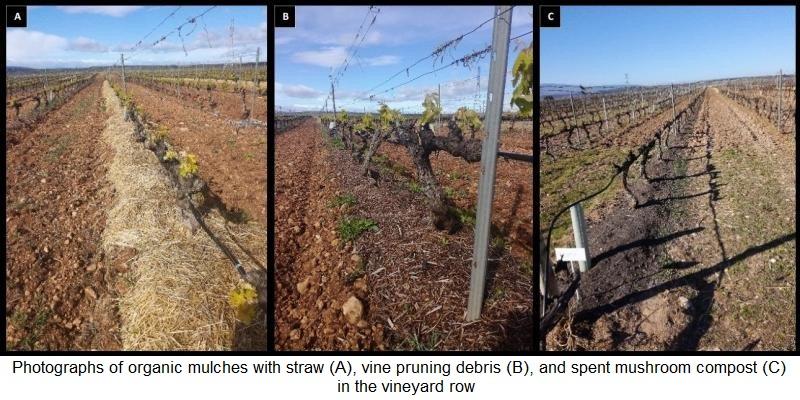Recently, researchers from the ICVV have published a scientific study in the journal Food Chemistry under the title "Organic mulches slightly influence the wine phenolic profile and sensory evaluation." The study investigates different alternatives to conventional soil management practices in the vineyard row, based on the use of various types of organic mulch, and how this alternative management can influence the physicochemical properties, phenolic composition, and sensory characteristics of wine made from the Tempranillo grape variety. Conducted over four years (2019 to 2022), the study compared three types of organic mulch (grapevine pruning debris, straw, and spent mushroom compost) and two conventional soil management practices (tillage and herbicide). Additionally, the research was carried out simultaneously in two different vineyards located in Aldeanueva de Ebro and Logroño.
The analysis of the wines made from the different mulch treatments revealed higher values of pH, potassium, and hue, as well as lower concentration of tartaric acid. Specifically, mulching with spent mushroom compost resulted in wines with lower concentrations of anthocyanins, flavonols, and hydroxycinnamic acids, possibly due to greater vine vigour caused by increased nutrient availability in the soil.
Despite the differences in physicochemical composition, the sensory analysis of the wines did not reveal significant differences between the different mulch treatments and conventional practices. The results suggest that organic mulches, compared to conventional soil management practices, could be a viable soil management alternative to mitigate the effects of climate change on viticulture and reduce the input of chemical inputs into the environment without having a notable impact on the sensory properties of young wine.
However, the researchers highlight the need for future studies focusing on the evolution of the wine's composition and sensory properties during aging. This is crucial, as wines made from mulching treatments could present less desirable characteristics for wine aging, such as elevated pH levels and low tartaric acid and anthocyanin contents.
The research was co-funded by the European Regional Development Fund (ERDF) and Ministerio de Ciencia e Innovación (MCIN) (RTI2018-095748-R-I00). A.M. thanks ERDF/MCIN for his predoctoral contract (PRE2019-089110). M.P. and D.L. thank the Government of La Rioja for their FPI research grants.
The authors thank Pernod Ricard wineries and D. Mateos for providing their vineyards for this research and highlight that the UHPLC-QqQ (MS/MS) method used for the analysis of phenolic compounds was developed at the Instrumental Analysis Service of the ICVV.
The work has been published in the Open Access modality in the journal Food Chemistry:
Andreu Mairata, Alicia Pou, Juana Martínez, Miguel Puelles, David Labarga, Javier Portu. (2024). Organic mulches slightly influence the wine phenolic profile and sensory evaluation (Spain). Food Chemistry, 457:140045
https://doi.org/10.1016/j.foodchem.2024.140045









